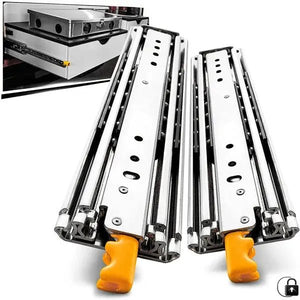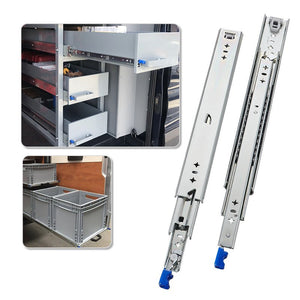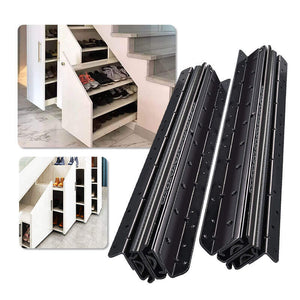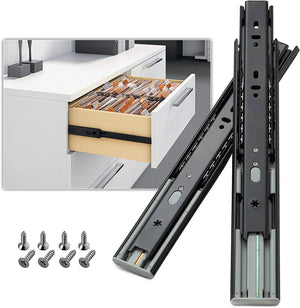I. Introduction
When it comes to the functionality of doors, the often-overlooked hero is the humble door hinge. Proper door hinge installation is not merely a task; it's an art that influences door stability, smooth operation, and longevity. In this comprehensive guide, we'll delve into the intricacies of installing door hinges correctly, ensuring that every swing and closure is a testament to precision and craftsmanship.
Before we embark on our journey of mastering the art of door hinge installation, let's acknowledge the common challenges faced by users. Misalignment, uneven gaps, and the dreaded squeaks can turn a seemingly simple task into a frustrating ordeal. By understanding these challenges, we can tailor our approach to address them effectively, ensuring a seamless installation experience for users.

II. Essential Tools and Materials
To embark on a successful door hinge installation journey, one must first assemble the right set of tools. Here's a comprehensive list to ensure you have everything you need:
1.Screwdriver Set
A variety of screwdrivers, including Phillips and flat-head, is indispensable for securing hinges in place. Ensure they match the screws provided with your chosen hinges.
2. Chisels
Chisels aid in carving out recesses for hinges, allowing them to sit flush with the door and frame. Opt for a sharp set to ensure clean and precise cuts.
3. Wood Filler
For minor gaps or imperfections, wood filler comes to the rescue. Choose a color that matches your door, providing a seamless finish after installation.
4. Tape Measure
Accurate measurements are the foundation of a successful installation. A reliable tape measure ensures your hinges are aligned, preventing misalignment issues down the line.
5. Hammer
A hammer helps secure the chisel and can be useful for any minor adjustments needed during installation. Choose one with a comfortable grip for ease of use.

Quality Materials for a Lasting Impression
Equally important as the tools are the materials you choose. The success of your door hinge installation relies on the quality of the hinges and accompanying accessories:
Invest in hinges made from durable materials like stainless steel or brass. The hinge type should complement your door's style and weight.
2. Screws
Ensure the screws provided with your hinges are of the appropriate length. Using screws that are too short can compromise the stability of the installation.
3. Pilot Hole Drill Bits
Drilling pilot holes prevents wood from splitting and ensures screws go in smoothly. Select drill bits matching the size of your screws for precise results.
4. Level: Keeping It Straight
A level is crucial for maintaining the straight alignment of your door. It ensures your efforts result in a professionally installed, aesthetically pleasing outcome.
Gathering these tools and materials is the first step toward a successful door hinge installation. In the next section, we'll dive into the diagnosis of common issues, helping you understand the intricacies before you begin.

III. Step-by-Step Guide: The Door Hinge Installation
Before diving into the installation process, meticulous preparation is key. Follow these steps to set the stage for a seamless door hinge installation:
1. Assess Your Door and Frame
Examine your door and frame for any existing damage or misalignments. Addressing these issues beforehand ensures a smooth installation process.
2. Choose the Right Hinges
Select hinges that not only complement your door aesthetically but also support its weight and usage. Consider factors like door material, weight, and desired hinge style.
3. Measure Twice, Cut Once: Precision Matters
Accurate measurements are non-negotiable. Measure the hinge placement on both the door and the frame, ensuring symmetry and proper alignment.
4. Mark Hinge Locations
Mark the determined hinge locations on both the door and frame using a pencil or a marking tool. This serves as a visual guide during the installation.
5. Gather Tools and Materials: The Installer's Arsenal
Ensure you have all the tools and materials from the essential list. Having everything at arm's reach minimizes interruptions during the installation process.

The Installation Dance
Now that your stage is set, let's dive into the intricate dance of door hinge installation:
1. Chiseling Recesses: Carving a Niche
Using the chisels, carefully carve out recesses on the door and frame at the marked hinge locations. Take your time to achieve a snug fit for the hinges.
2. Attach Hinges to the Door: Secure and Align
Fix the hinges onto the door using the provided screws. Ensure they sit flush in the recesses and are properly aligned with the marked locations.
3. Position the Frame
With the door temporarily secured, align the hinges on the frame with those on the door. This step is crucial for a door that swings seamlessly without resistance.
4. Screw Them In
Secure the hinges to the frame using the designated screws. Take care not to overtighten, ensuring the door swings freely without any unnecessary friction.
5. Test the Swing: Ensuring Smooth Movement
Open and close the door several times to ensure it moves smoothly. Check for any signs of misalignment or resistance, making adjustments as needed.
6. Fine-Tuning: Addressing Imperfections
If the door doesn't close perfectly or exhibits any issues, use wood filler to address minor imperfections. Sand the filled areas for a flawless finish.
This step-by-step guide empowers you to master the art of door hinge installation. In the next section, we'll explore troubleshooting and maintenance tips to ensure the longevity of your newly installed hinges.

IV. Testing and Maintenance
After successfully installing your door hinges, it's imperative to subject them to rigorous testing to guarantee their quality and functionality.
1. Smooth Swing Verification
Open and close the door repeatedly, paying close attention to the smoothness of the swing. Any unexpected resistance or misalignment should be addressed promptly.
2. Weight Endurance Test
Apply gradual pressure to the door, testing its ability to support weight. This step ensures the hinges can endure the door's intended usage without strain.
3. Alignment Check
Verify that the door maintains proper alignment with the frame during each swing. Misalignments can lead to premature wear and tear, affecting both aesthetics and functionality.
4. Noise Assessment
Listen for any unusual noises during door movement. Applying lubricant to the hinges can eliminate creaks and squeaks, enhancing the overall user experience.
5. Security Evaluation
Confirm the hinges provide the necessary security by ensuring the door remains securely in place when closed. Any wobbling or instability may compromise safety.

Proactive Maintenance for Longevity
Regular maintenance is the key to extending the lifespan of your door hinges. Follow these proactive steps to keep them in optimal condition:
1. Lubrication Routine
Apply a silicone-based lubricant to the hinges annually. This prevents friction, reduces wear, and ensures the hinges operate smoothly.
2. Tightening Loose Screws
Periodically check for any loose screws and tighten them as needed. This simple step maintains the structural integrity of the hinges.
3. Inspection for Wear
Regularly inspect the hinges for signs of wear, rust, or corrosion. Addressing these issues promptly prevents further damage and preserves the aesthetic appeal.
4. Cleaning: Removing Accumulated Debris
Clean the hinges regularly to remove dust, dirt, and debris. Accumulated particles can hinder movement and lead to performance issues.
5. Adjustment for Alignment
If misalignment occurs over time, make the necessary adjustments to maintain proper door alignment. This proactive approach prevents unnecessary strain on the hinges.
By incorporating these testing and maintenance practices into your routine, you ensure the longevity and optimal performance of your door hinges. In the next section, we'll delve into customer testimonials, sharing real experiences and insights.

V. Frequently Asked Questions
In this section, we address some frequently asked questions regarding door hinge installation to provide clarity and assistance to our customers.
How do I choose the right door hinge for my project?
Choosing the right door hinge involves considering factors such as door weight, material, and desired functionality. Heavy doors may require hinges with a higher weight capacity, while material compatibility ensures longevity. Functionality, including standard or concealed hinges, depends on the aesthetic and functional preferences of the user.
Can I install door hinges on my own, or should I hire a professional?
The installation of door hinges can be a DIY project for those with some experience in carpentry. However, for complex projects or if unsure about the process, hiring a professional ensures proper installation, minimizing the risk of errors and enhancing the longevity of the hinges.
What tools do I need for installing door hinges?
Basic tools required for door hinge installation include a screwdriver, chisel, tape measure, and a drill. The specific tools needed may vary based on the hinge type and the complexity of the installation. Refer to our comprehensive guide in Section II for a detailed list of essential tools and materials.
How often should I perform maintenance on my door hinges?
Regular maintenance is crucial for ensuring the optimal performance and longevity of door hinges. A yearly maintenance routine, including lubrication, tightening loose screws, and inspecting for wear, is recommended. However, the frequency may vary based on factors such as usage and environmental conditions.
Can I use the same hinges for interior and exterior doors?
While some hinges may be suitable for both interior and exterior doors, it's essential to consider environmental factors. For exterior doors exposed to the elements, corrosion-resistant materials and weatherproof hinges are recommended. Interior doors may have more flexibility in hinge selection.
What is the purpose of adjusting door hinges?
Adjusting door hinges is essential for maintaining proper alignment, preventing issues such as sticking or misalignment. It allows users to fine-tune the position of the door, ensuring smooth operation and preventing premature wear on hinges and door components.
By addressing these frequently asked questions, we aim to empower our customers with the knowledge needed for successful door hinge installation and maintenance. In the next section, we'll conclude our guide by summarizing the key takeaways and emphasizing the importance of high-quality door hinges.
VI. Conclusion
In conclusion, the art of door hinge installation is more than just a practical necessity; it's an opportunity to enhance the functionality, aesthetics, and longevity of your doors. Choosing the right hinges, employing proper installation techniques, and adopting a proactive approach to maintenance can significantly elevate your door installation experience.
At AOLISHENG, we understand the pivotal role door hinges play in your daily life. That's why we are committed to providing high-quality hinges that meet the diverse needs of our customers. Our range of hinges, from standard to specialized varieties, ensures that you find the perfect fit for your project.
As you embark on your next door installation or renovation project, consider the impact that quality door hinges can make. Elevate your experience with hinges that blend seamlessly into your design, operate effortlessly, and stand the test of time. Choose AOLISHENG for a reliable partner in achieving a door installation that surpasses expectations.
In closing, AOLISHENG is dedicated to not just meeting but exceeding your door installation expectations. Elevate your doors, elevate your space, and let quality hinges be the silent heroes that ensure a lasting and satisfying experience every time you open or close a door.
Thank you for choosing AOLISHENG, where quality meets excellence in every hinge.





